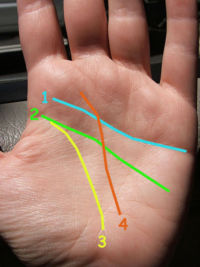Palm reading, palmistry or chiromancy is a popular art in Asia, though its popularity has grown in other parts of the world over the years. A person's hands are imprinted with many of these markings from birth while others appear as the hands grow and change, so in many cases palm reading focuses more on how these lines interact rather than what the lines look like. These relationships can be used to determine health, mental, emotional and physical characteristics which can have an impact on the person whose palm is being read.
What is Palm Reading or Palmistry?
The art of palm reading, commonly referred to as palmistry, is based on the idea that you can tell someone's future based on the imprints and markings found on the palm of their hands. Lines on the palm may either be large and thick, or thin and small. Mounts, markings and how the lines cross or interact with one another on both of the hands are considered when reading a palm. In some cases characteristics of the arm, fingers and nails will also be considered when determining the future and characteristics of the person whose palm is being read.
Palm Reading Guide: How to Read
Which Hand to Use
The first step in palm reading is determining which hand should be used. In many cases both hands will be read, but different age and gender groups should have different hands used as their primary reading source. The left hand, or the "born to be" hand represents characteristics that were inherent to the person from birth. The right hand, or the "grown to be" hand will represent the status and achievements that are earned as people grow and gain their independence. The right and left hands also represent Ying and Yang, respectively.
- Men who are less than 30 years old should have the left hand used as their primary hand, while the right hand will be used as a supplementary hand for additional information.
- A man over 30 should use the exact opposite of this method. This is because as a young man, you will be more influenced by your parents, upbringing and heritage, while as an adult you are more independent and things such as health, social status and outside relationships tend to have more value.
- Women under 30 should use the right hand as their primary hand due to its association with Ying, and should switch to using the left hand as their primary reading hand once they age past 30.
Identifying Major Lines
Once you have selected the proper hand to use, it is time to start identifying the major lines which affect the reading.
Heart line - The first to locate is the heart line. This line is near the top of the palm and extends from the index finger and can extend through the pinkie. If the line is long that implies a steady love life, while shorter lines imply that this person may fall in love easily or may be a bit less interested in romance. If the line is curvy then this person may have many different relationships or express their feelings more openly, while a straight line implies that this person is more likely to keep their head in romantic situations. Breaks or circles in the line signify emotional trauma.
Head line - The head line, which runs horizontally through the center of the palm represents this person's thinking style. Curved lines represent people who are more creative or spontaneous while a straight line implies that this person is more straightforward. If this line does not touch the life line it implies that this person is adventurous. Breaks in the head line show inconsistencies and doughnuts or crosses imply emotional crises that the person has suffered.
Life line - The next major line down in palm reading guide, starting near the thumb and curving in an arc is the life line. Many palm readers consider this one of the most important line on the hand. This line reflects health, major life changes or the person's well-being. The depth of this line implies vitality, while shallow lines imply that this person can be easily manipulated. In some cases, a person will have multiple life lines which implies that they are especially vital. Breaks in the line imply sudden changes in lifestyle while circles imply major injuries or illnesses. Swoops or a semicircle on the fate line shows the enthusiasm and strength the person lends to their life.
Fate line - The final major line is the fate line, which represents items that are beyond the person's control. This line is more vertical and cuts through the center of the palm. If this line is deep this person is strongly controlled by their fate, while a lighter line implies that they have more freedom. Many breaks in this line imply that the person's life is often changed by external forces, but if the line joins the life line this implies that the person set their aspirations and goals very early on. If this line hits the life line in the center this signifies a point where the person must surrender to the will of others. However, if it starts at the base of the thumb and completely crosses the life line this shows that this person is strongly supported by their friends and family.
Hope this palm reading guide help you understand the art better and you can get started reading your palms or others!

